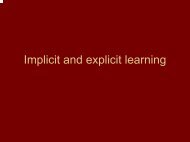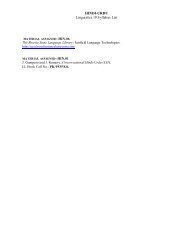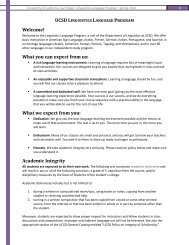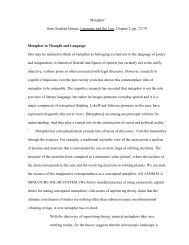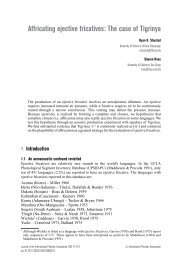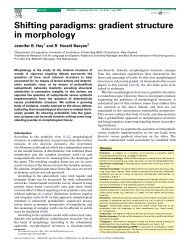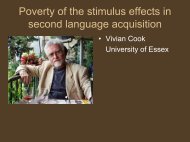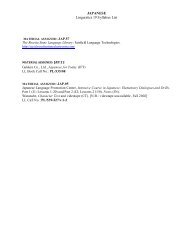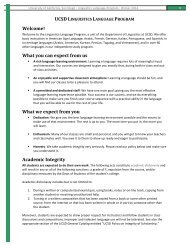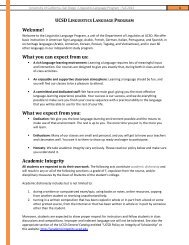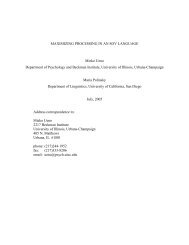Paradigms and Periphrastic Expression - Linguistics - UC San Diego
Paradigms and Periphrastic Expression - Linguistics - UC San Diego
Paradigms and Periphrastic Expression - Linguistics - UC San Diego
Create successful ePaper yourself
Turn your PDF publications into a flip-book with our unique Google optimized e-Paper software.
II. <strong>Paradigms</strong> for predicates: Morphosyntax <strong>and</strong> exponence in the Permian language<br />
Votyak (Udmurt) - Word Order: SUBJ OBJ PREDICATE; [ (NEG) V (COP) predicate ]<br />
6. What are the morphosyntactic paradigm categories for verbal lexemes in Votyak? 4<br />
• {[PERSON: 1, 2, 3], [NUMBER: sg, pl], [TENSE: present, continutive past, future, imperfective<br />
past, 1 st past, 2 nd past (=perfect), …], [MOOD: indicative, imperative, narrative (=<br />
inferential)..], [POLARITY: affirmative, negative]} - (following Suihkonen 1996)<br />
7. Diachronic development of person/number marking for negative polarity:<br />
À Reconstructed paradigms for affirmative (Serebrennikov 1963:235 5 ) <strong>and</strong> negative<br />
(Serebrennikov 1963:287) present tense of Proto-Permian mγnγ - `go':<br />
7A. [POL:aff], [TNS:present]: [POL:neg], [TNS:present]:<br />
SG.1. mγnam `I am going' SG.1. om mγnγ 6 `I am not going'<br />
2. mγnad 2. ot mγnγ<br />
3. mγna 3. ok mγnγ<br />
PL.1. mγnamV PL.1. om mγnγ<br />
2. mγnadV 2. ot mγnγ<br />
3. mγnazV 3. ok mγnγ<br />
• Distinctive marking for person & number in affirmative present tense.<br />
• Only person distinctions in negative present tense.<br />
• Invariant connegative forms. 7<br />
4 Suihkonen 1995:298 writes: "The categories occurring in verbal conjugation are person, tense, mood,<br />
negation…" This is a restatement of the relevant categories for verbal paradigms found in Suihkonen<br />
190:95.<br />
5 γ is a diacritic used by Serebrennikov to indicate variable quality for a vowel.<br />
6 The paradigms will reveal a large amount of syncretrism in the actual forms used to express<br />
morphosyntactic features, but I will ignore for the most part the actual realizational rules <strong>and</strong> associated<br />
systematicities of form, focusing simply on synthetic versus periphrastic expresssion. I assume that<br />
something on the order of rules of referral need to be formulated here (see Zwicky 1990, Stump 1993, to<br />
appear.<br />
7 Invariance of the connegative (with respect to number in the present tense) still exists in numerous Finnic<br />
languages, e.g., Finnish en lue `I’m not reading.’ & emme lue `We’re not reading.’ (see Serebrennikov<br />
1964:140).<br />
4



